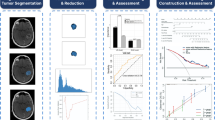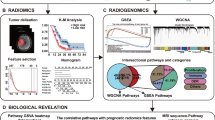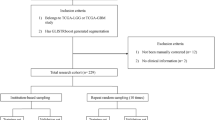Abstract
The purpose of this study is to predict the mRNA expression of CSF1R in HGG non-invasively using MRI (magnetic resonance imaging) omics technology and to evaluate the correlation between the established radiomics model and prognosis. We investigated the predictive value of CSF1R in the Cancer Genome Atlas (TCGA) and The Cancer Imaging Archive (TCIA) database. The Support vector machine (SVM) and the Logistic regression (LR) algorithms were used to create a radiomics_score (Rad_score), respectively. The effectiveness and performance of the radiomics model was assessed in the training (n = 89) and tenfold cross-validation sets. We further analyzed the correlation between Rad_score and macrophage-related genes using Spearman correlation analysis. A radiomics nomogram combining the clinical factors and Rad_score was constructed to validate the radiomic signatures for individualized survival estimation and risk stratification. The results showed that CSF1R expression was markedly elevated in HGG tissues, which was related to worse prognosis. CSF1R expression was closely related to the abundance of infiltrating immune cells, such as macrophages. We identified nine features for establishing a radiomics model. The radiomics model predicting CSF1R achieved high AUC in training (0.768 in SVM and 0.792 in LR) and tenfold cross-validation sets (0.706 in SVM and 0.717 in LR). Rad_score was highly associated with tumor-related macrophage genes. A radiomics nomogram combining the Rad_score and clinical factors was constructed and revealed satisfactory performance. MRI-based Rad_score is a novel way to predict CSF1R expression and prognosis in high-grade glioma patients. The radiomics nomogram could optimize individualized survival estimation for HGG patients.










Similar content being viewed by others
Data Availability
If the requirement is reasonable, any original data of this study can be obtained from the author.
References
Sung H, et al.: Global Cancer Statistics 2020: GLOBOCAN Estimates of Incidence and Mortality Worldwide for 36 Cancers in 185 Countries. CA: a cancer journal for clinicians 71:209–249, 2021
Gupta A, Dwivedi T: A Simplified Overview of World Health Organization Classification Update of Central Nervous System Tumors 2016. Journal of neurosciences in rural practice 8:629-641, 2017
Larsen J, et al.: 'Low grade glioma': an update for radiologists. The British journal of radiology 90:20160600, 2017
Brat DJ, et al.: Comprehensive, Integrative Genomic Analysis of Diffuse Lower-Grade Gliomas. The New England journal of medicine 372:2481-2498, 2015
Omuro A, DeAngelis LM: Glioblastoma and other malignant gliomas: a clinical review. Jama 310:1842-1850, 2013
Louis DN, et al.: The 2016 World Health Organization Classification of Tumors of the Central Nervous System: a summary. Acta neuropathologica 131:803-820, 2016
Ostrom QT, et al.: CBTRUS Statistical Report: Primary brain and other central nervous system tumors diagnosed in the United States in 2010-2014. Neuro-oncology 19:v1-v88, 2017
Aum DJ, Kim DH, Beaumont TL, Leuthardt EC, Dunn GP, Kim AH: Molecular and cellular heterogeneity: the hallmark of glioblastoma. Neurosurgical focus 37:E11, 2014
Hume DA: The mononuclear phagocyte system. Current opinion in immunology 18:49-53, 2006
Chitu V, Biundo F, Stanley ER: Colony stimulating factors in the nervous system. Seminars in immunology 54:101511, 2021
Wiehagen KR, et al.: Combination of CD40 Agonism and CSF-1R Blockade Reconditions Tumor-Associated Macrophages and Drives Potent Antitumor Immunity. Cancer immunology research 5:1109-1121, 2017
Quail DF, et al.: The tumor microenvironment underlies acquired resistance to CSF-1R inhibition in gliomas. Science 352:aad3018, 2016
Butowski N, et al.: Orally administered colony stimulating factor 1 receptor inhibitor PLX3397 in recurrent glioblastoma: an Ivy Foundation Early Phase Clinical Trials Consortium phase II study. Neuro-oncology 18:557-564, 2016
Patwardhan PP, et al.: Sustained inhibition of receptor tyrosine kinases and macrophage depletion by PLX3397 and rapamycin as a potential new approach for the treatment of MPNSTs. Clinical cancer research : an official journal of the American Association for Cancer Research 20:3146-3158, 2014
Pyonteck SM, et al.: CSF-1R inhibition alters macrophage polarization and blocks glioma progression. Nature medicine 19:1264-1272, 2013
Zonari P, Baraldi P, Crisi G: Multimodal MRI in the characterization of glial neoplasms: the combined role of single-voxel MR spectroscopy, diffusion imaging and echo-planar perfusion imaging. Neuroradiology 49:795-803, 2007
Lu CF, et al.: Machine Learning-Based Radiomics for Molecular Subtyping of Gliomas. Clinical cancer research : an official journal of the American Association for Cancer Research 24:4429-4436, 2018
Zhou H, et al.: MRI features predict survival and molecular markers in diffuse lower-grade gliomas. Neuro-oncology 19:862-870, 2017
Artzi M, Bressler I, Ben Bashat D: Differentiation between glioblastoma, brain metastasis and subtypes using radiomics analysis. Journal of magnetic resonance imaging : JMRI 50:519-528, 2019
Lambin P, et al.: Radiomics: the bridge between medical imaging and personalized medicine. Nature reviews Clinical oncology 14:749-762, 2017
Leu K, et al.: Perfusion and diffusion MRI signatures in histologic and genetic subtypes of WHO grade II-III diffuse gliomas. Journal of neuro-oncology 134:177-188, 2017
Reza SMS, Samad MD, Shboul ZA, Jones KA, Iftekharuddin KM: Glioma grading using structural magnetic resonance imaging and molecular data. Journal of medical imaging (Bellingham, Wash) 6:024501, 2019
Zeng WJ, et al.: Integrative Analysis of DNA Methylation and Gene Expression Identify a Three-Gene Signature for Predicting Prognosis in Lower-Grade Gliomas. Cellular physiology and biochemistry : international journal of experimental cellular physiology, biochemistry, and pharmacology 47:428-439, 2018
Beig N, et al.: Radiogenomic-Based Survival Risk Stratification of Tumor Habitat on Gd-T1w MRI Is Associated with Biological Processes in Glioblastoma. Clinical cancer research : an official journal of the American Association for Cancer Research 26:1866-1876, 2020
Bodalal Z, Trebeschi S, Nguyen-Kim TDL, Schats W, Beets-Tan R: Radiogenomics: bridging imaging and genomics. Abdominal radiology (New York) 44:1960-1984, 2019
Cohen AL, Holmen SL, Colman H: IDH1 and IDH2 mutations in gliomas. Current neurology and neuroscience reports 13:345, 2013
Boots-Sprenger SH, et al.: Significance of complete 1p/19q co-deletion, IDH1 mutation and MGMT promoter methylation in gliomas: use with caution. Modern pathology : an official journal of the United States and Canadian Academy of Pathology, Inc 26:922–929, 2013
Vivian J, et al.: Toil enables reproducible, open source, big biomedical data analyses. Nature biotechnology 35:314-316, 2017
Kim JY, et al.: Incorporating diffusion- and perfusion-weighted MRI into a radiomics model improves diagnostic performance for pseudoprogression in glioblastoma patients. Neuro-oncology 21:404-414, 2019
Hong JH, et al.: Development and Validation of a Radiomics Model for Differentiating Bone Islands and Osteoblastic Bone Metastases at Abdominal CT. Radiology 299:626-632, 2021
Yu Y, et al.: Development and Validation of a Preoperative Magnetic Resonance Imaging Radiomics-Based Signature to Predict Axillary Lymph Node Metastasis and Disease-Free Survival in Patients With Early-Stage Breast Cancer. JAMA network open 3:e2028086, 2020
Lv L, et al.: Radiomic analysis for predicting prognosis of colorectal cancer from preoperative (18)F-FDG PET/CT. J Transl Med 20:66, 2022
Fang Q, Chen H: The significance of m6A RNA methylation regulators in predicting the prognosis and clinical course of HBV-related hepatocellular carcinoma. Molecular medicine (Cambridge, Mass) 26:60, 2020
McKenney AS, et al.: Radiomic Analysis to Predict Histopathologically Confirmed Pseudoprogression in Glioblastoma Patients. Advances in Radiation Oncology:100916, 2022
Patel M, et al.: Machine learning-based radiomic evaluation of treatment response prediction in glioblastoma. Clinical Radiology 76:628.e617-628.e627, 2021
Saltybaeva N, et al.: Robustness of radiomic features in magnetic resonance imaging for patients with glioblastoma: Multi-center study. Physics and Imaging in Radiation Oncology 22:131-136, 2022
Xu Y, He X, Li Y, Pang P, Shu Z, Gong X: The Nomogram of MRI-based Radiomics with Complementary Visual Features by Machine Learning Improves Stratification of Glioblastoma Patients: A Multicenter Study. J Magn Reson Imaging 54:571-583, 2021
Eckel-Passow JE, et al.: Glioma Groups Based on 1p/19q, IDH, and TERT Promoter Mutations in Tumors. The New England journal of medicine 372:2499-2508, 2015
Patel SH, et al.: T2-FLAIR Mismatch, an Imaging Biomarker for IDH and 1p/19q Status in Lower-grade Gliomas: A TCGA/TCIA Project. Clinical cancer research : an official journal of the American Association for Cancer Research 23:6078-6085, 2017
Su X, et al.: A radiomics-clinical nomogram for preoperative prediction of IDH1 mutation in primary glioblastoma multiforme. Clin Radiol 75:963.e967-963.e915, 2020
Prestwich RJ, Sivapalasunrtharam A, Johnston C, Evans K, Gerrard GE: Survival in high-grade glioma: a study of survival in patients unfit for or declining radiotherapy. Clinical oncology (Royal College of Radiologists (Great Britain)) 17:133–137, 2005
Akkari L, et al.: Dynamic changes in glioma macrophage populations after radiotherapy reveal CSF-1R inhibition as a strategy to overcome resistance. Sci Transl Med 12, 2020
Almahariq MF, Quinn TJ, Kesarwani P, Kant S, Miller CR, Chinnaiyan P: Inhibition of Colony-Stimulating Factor-1 Receptor Enhances the Efficacy of Radiotherapy and Reduces Immune Suppression in Glioblastoma. In vivo (Athens, Greece) 35:119-129, 2021
Domingues P, et al.: Tumor infiltrating immune cells in gliomas and meningiomas. Brain, behavior, and immunity 53:1-15, 2016
Gajewski TF, Schreiber H, Fu YX: Innate and adaptive immune cells in the tumor microenvironment. Nature immunology 14:1014-1022, 2013
Mao X, et al.: Crosstalk between cancer-associated fibroblasts and immune cells in the tumor microenvironment: new findings and future perspectives. Mol Cancer 20:131, 2021
Vitale I, Manic G, Coussens LM, Kroemer G, Galluzzi L: Macrophages and Metabolism in the Tumor Microenvironment. Cell metabolism 30:36-50, 2019
Chanmee T, Ontong P, Konno K, Itano N: Tumor-associated macrophages as major players in the tumor microenvironment. Cancers 6:1670-1690, 2014
Perreault S, et al.: A phase 2 study of trametinib for patients with pediatric glioma or plexiform neurofibroma with refractory tumor and activation of the MAPK/ERK pathway: TRAM-01. BMC Cancer 19:1250, 2019
He L, Zhou H, Zeng Z, Yao H, Jiang W, Qu H: Wnt/β-catenin signaling cascade: A promising target for glioma therapy. Journal of cellular physiology 234:2217-2228, 2019
Le Rhun E, et al.: Molecular targeted therapy of glioblastoma. Cancer Treat Rev 80:101896, 2019
Fathi Kazerooni A, et al.: Applications of Radiomics and Radiogenomics in High-Grade Gliomas in the Era of Precision Medicine. Cancers 13, 2021
Gillies RJ, Schabath MB: Radiomics Improves Cancer Screening and Early Detection. Cancer epidemiology, biomarkers & prevention : a publication of the American Association for Cancer Research, cosponsored by the American Society of Preventive Oncology 29:2556-2567, 2020
Lu J, Li X, Li H: A radiomics feature-based nomogram to predict telomerase reverse transcriptase promoter mutation status and the prognosis of lower-grade gliomas. Clin Radiol, 2022
Xi YB, et al.: Radiomics signature: A potential biomarker for the prediction of MGMT promoter methylation in glioblastoma. Journal of magnetic resonance imaging : JMRI 47:1380-1387, 2018
Wang Y, Shao Q, Luo S, Fu R: Development of a nomograph integrating radiomics and deep features based on MRI to predict the prognosis of high grade Gliomas. Mathematical biosciences and engineering : MBE 18:8084-8095, 2021
Ding J, et al.: Developing and validating a deep learning and radiomic model for glioma grading using multiplanar reconstructed magnetic resonance contrast-enhanced T1-weighted imaging: a robust, multi-institutional study. Quantitative imaging in medicine and surgery 12:1517-1528, 2022
Jeannin P, Paolini L, Adam C, Delneste Y: The roles of CSFs on the functional polarization of tumor-associated macrophages. The FEBS journal 285:680-699, 2018
Lei F, Cui N, Zhou C, Chodosh J, Vavvas DG, Paschalis EI: CSF1R inhibition by a small-molecule inhibitor is not microglia specific; affecting hematopoiesis and the function of macrophages. Proc Natl Acad Sci U S A 117:23336-23338, 2020
Collins GS, Reitsma JB, Altman DG, Moons KG: Transparent reporting of a multivariable prediction model for individual prognosis or diagnosis (TRIPOD): the TRIPOD statement. Bmj 350:g7594, 2015
Patil N, et al.: Independently validated sex-specific nomograms for predicting survival in patients with newly diagnosed glioblastoma: NRG Oncology RTOG 0525 and 0825. Journal of neuro-oncology 155:363-372, 2021
Tian H, Wu H, Wu G, Xu G: Noninvasive Prediction of TERT Promoter Mutations in High-Grade Glioma by Radiomics Analysis Based on Multiparameter MRI. BioMed research international 2020:3872314, 2020
Tan Y, Mu W, Wang XC, Yang GQ, Gillies RJ, Zhang H: Improving survival prediction of high-grade glioma via machine learning techniques based on MRI radiomic, genetic and clinical risk factors. European journal of radiology 120:108609, 2019
Mun EJ, Babiker HM, Weinberg U, Kirson ED, Von Hoff DD: Tumor-Treating Fields: A Fourth Modality in Cancer Treatment. Clinical cancer research : an official journal of the American Association for Cancer Research 24:266-275, 2018
Kirson ED, et al.: Alternating electric fields arrest cell proliferation in animal tumor models and human brain tumors. Proceedings of the National Academy of Sciences of the United States of America 104:10152-10157, 2007
Stupp R, et al.: Maintenance Therapy With Tumor-Treating Fields Plus Temozolomide vs Temozolomide Alone for Glioblastoma: A Randomized Clinical Trial. Jama 314:2535-2543, 2015
Ghiaseddin AP, Shin D, Melnick K, Tran DD: Tumor Treating Fields in the Management of Patients with Malignant Gliomas. Current treatment options in oncology 21:76, 2020
Guo X, et al.: Tumor-Treating Fields in Glioblastomas: Past, Present, and Future. Cancers 14, 2022
Acknowledgements
We thank Dr. Di Zhou for providing financial support.
Funding
This study was supported by the National Natural Science Foundation of China (No.82002538 and No. 82372502). Science and Technology Commission of Shanghai Municipality-Medical Innovation Research Special Project (23Y11902300); Zhongshan Hospital Clinical Research Special Funding (ZSLCYJ202346); Natural Science Foundation of Shanghai Municipal Commission of Science and Technology (No. 23ZR1411400).
Author information
Authors and Affiliations
Contributions
M.L.W. designed the study; M.L.W., Y.L.L, Y.Y.W. and X.Y.C. performed the research; M.L.W., Y.L.L. and Y.Y.W analyzed the data; M.L.W., Y.L.L. wrote the paper. M.L.W., G.X.Z. and W.C.G revised the paper.
Corresponding authors
Ethics declarations
Ethics Approval
This is an observational study. The Zhongshan hospital Research Ethics Committee has confirmed that no ethical approval is required.
Consent to Participate
Not applicable.
Consent for Publication
Not applicable.
Competing Interests
The authors claim that they have no competing interests.
Additional information
Publisher's Note
Springer Nature remains neutral with regard to jurisdictional claims in published maps and institutional affiliations.
Supplementary Information
Below is the link to the electronic supplementary material.
Rights and permissions
Springer Nature or its licensor (e.g. a society or other partner) holds exclusive rights to this article under a publishing agreement with the author(s) or other rightsholder(s); author self-archiving of the accepted manuscript version of this article is solely governed by the terms of such publishing agreement and applicable law.
About this article
Cite this article
Lai, Y., Wu, Y., Chen, X. et al. MRI-based Machine Learning Radiomics Can Predict CSF1R Expression Level and Prognosis in High-grade Gliomas. J Digit Imaging. Inform. med. 37, 209–229 (2024). https://doi.org/10.1007/s10278-023-00905-x
Received:
Revised:
Accepted:
Published:
Issue Date:
DOI: https://doi.org/10.1007/s10278-023-00905-x




